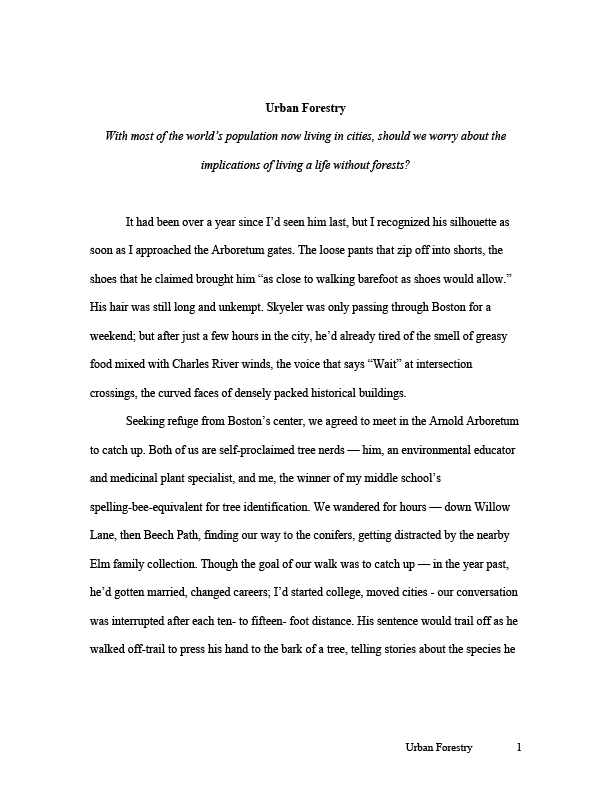“Urban Forestry” won first place in the DeWitt Wallace Prize for Science Writing for the Public, part of the 2019 Ilona Karmel Writing Prizes.
It had been over a year since I’d seen him last, but I recognized his silhouette as soon as I approached the Arboretum gates. The loose pants that zip off into shorts, the shoes that he claimed brought him “as close to walking barefoot as shoes would allow.” His hair was still long and unkempt. Skyeler was only passing through Boston for a weekend; but after just a few hours in the city, he’d already tired of the smell of greasy food mixed with Charles River winds, the voice that says “Wait” at intersection crossings, the curved faces of densely packed historical buildings.
Seeking refuge from Boston’s center, we agreed to meet in the Arnold Arboretum to catch up. Both of us are self-proclaimed tree nerds — him, an environmental educator and medicinal plant specialist, and me, the winner of my middle school’s spelling-bee-equivalent for tree identification. We wandered for hours — down Willow Lane, then Beech Path, finding our way to the conifers, getting distracted by the nearby Elm family collection. Though the goal of our walk was to catch up — in the year past, he’d gotten married, changed careers; I’d started college, moved cities – our conversation was interrupted after each ten- to fifteen- foot distance. His sentence would trail off as he walked off-trail to press his hand to the bark of a tree, telling stories about the species he recognized. To him, the dawn redwoods were sacred, the conifers were healing, the ginkgos were reminders of generations past.
While we chewed on white pine needles (sharing appreciation for their vitamin-c content), Skyeler mused: “MIT must be terrible.” I was caught off guard; how could he have concluded, from my stories of life at one of the world’s best universities, that MIT was anything but great? But he paused for a moment, walking up to a massive beech. “You probably never get to see something like this, walk through a space like this,” gesturing to the beech tree and the expanse of foliage and trails around us. He had a point. I described MIT’s highly manicured landscape — patches of grass cyclically killed by massive tents and resurrected by a sticky turquoise fertilizing spray; a street lined with suffering gingkos; towering sycamore trees with falling leaves raked up almost before touching the ground. Although the landscapes of MIT serve important ecological and aesthetic purposes, Killian court’s oaks and fescue offer no comparison to the serenity and beauty of the Arboretum. There was something different about the way the two spaces made me think and feel.
The ecological role of trees in urban environments
Whether growing alongside buildings on MIT’s campus, shading the parking lot of a strip mall, or filling New York City’s iconic Central Park, trees are an essential part of a healthy city. Urban forestry is the study of the role — or more accurately, the various aesthetic, environmental, economic, social, and political roles — trees can play in urban environments.10, 11 Trees in the City, a book published in 1977 (less than a decade after the term “urban forestry” was coined), notes that trees serve three essential ecological services in cities: “They act as air conditioners, noise reducers, and weather shields.”11 Trees filter polluted air and replenish oxygen supply. The shade of a tree, combined with the transpiration of moisture from its leaves, lowers air temperatures, cooling buildings and pedestrians alike. By providing buffers and interruptions for sound, a row of trees can reduce the noisiness of a busy city by 16 to 20 decibels.11 And, a green space can provide mitigation for extreme weather events, through the retention of snowmelt or by allowing rainfall to infiltrate slowly into the ground, reducing the stress placed on a city’s stormwater drainage systems.
In the years since 1977, even more benefits of trees in cities have been studied. The aesthetic beauty trees bring to a city can improve the moods of residents; and public green spaces promote exercise and social interaction, improving the population’s overall health.16 Furthermore, with climate change and its associated increase in the occurrence of extreme weather events, the ecological benefits of urban forestry are becoming more and more relevant.
These ecologic services lend themselves to economic benefits as well. A cost-benefit analysis of urban forestry published in the journal Landscape and Urban Planning assigned monetary prices to each of the costs, like installation, and benefits, like ecological services, associated with one city’s urban reforestation project. It was found that ecological services like temperature control led to an economic benefit-to-cost ratio of 2.6, and that this ratio increased with the tree’s age as the tree grew larger and provided more services.17 Monetary savings like this can provide an incentive for cities to incorporate trees and green space in their development plans.
Is urban forestry a priority for cities? Should it be?
Despite these ecological, social, and economic benefits, towns do not always prioritize trees and green spaces in their planning. Back home in Salisbury, North Carolina, our downtown shopping district was recently cleared of all its largest trees. The removal created a lot more empty space: an aesthetic shift which give more visibility to storefront advertisements. Though the scarred patches of soil left behind by the removed trees were eventually filled with saplings (whose trunks were only as thick as my wrist), from my view, the downtown still looked barren and exposed, and probably would for another twenty years until the trees began to claim more space. I felt a personal sense of loss when those trees were removed — my parents had planted them thirty years earlier when they were employees for the city’s landscaping department — but what did this removal mean for the rest of the city’s occupants?
To better understand the value of trees in cities, let’s examine the consequences of a city with nearly none. Dhaka, the capital of Bangladesh known for its high density and vulnerability to climate change,12 has less than five percent tree cover.13 Compared to a city like Boston, whose tree cover is nearly four times that and falls above the guidelines for a liveable city,14 Dhaka is close to barren of green space and foliage. Images of the city’s streets reveal a maze of concrete structures and roadways, with narrow streets unsoftened by greenery and impervious to water.
When storms hit Dhaka, parts of the the city flood easily as rainwaters overwhelm the city’s drainage system. Some of these floods are catastrophic, affecting infrastructure, public health, and utilities.18 When temperatures increase during heat waves, the city’s concrete intensifies the heat’s effect and offers few places for refuge.20 And, with Bangladesh identified as one of the world’s most vulnerable nations in the face of climate change — a phenomenon which exacerbates extreme weather such as storms, flooding, and heat waves — the lack of tree cover and greenery in Dhaka has left the city unprepared and increasingly at risk. Planners are now searching for ways to retro-fit the city with greenroofs to reduce extreme weather’s impact.8
What does a lack of trees mean for Dhaka’s residents? In many ways, green space in this city has become a matter of life or death, with people dying each year in the city from climate change related health risks, many of which could have been mitigated by trees and green space.
In the cases of both my hometown and Dhaka, the city had a goal or need that it prioritized over the planting or preservation of trees. In Dhaka, this need is extreme — the city is a site of refuge for migrants and displaced peoples across the country.10 Especially as extreme weather events mix with political and economic instability, more and more people in Bangladesh are driven to Dhaka – it is estimated that around 500,000 people move to Dhaka from other areas in Bangladesh each year. As a result, the city has faced rapid unplanned expansion, with most of the migrants ending up in slums.10
Considering the pressures of rapidly increasing population complemented by environmental, political, and economic instability, it is easy to understand why intentional incorporation of green space in urban planning was overlooked. Prioritizing trees is a privilege Dhaka has not been afforded. And, in my hometown, perhaps the revenue drawn from the more-visible storefronts and advertisements was viewed as more important to the town’s well being than the preservation of a few old trees. We cannot assume that all urban areas will be able to prioritize urban forestry. But, as the example of Dhaka reveals, there are tangible and unfortunate consequences to this reality. And, beyond the well-understood environmental hazards treeless cities face, new evidence is now revealing less visible consequences of a life without trees.
The hidden influence of trees on human health
Trees are increasingly studied as a tool not just for aesthetic and environmental benefit but as vital influencers of human health conditions in cities. The impact of green spaces on health has been well-documented: exposure to nature can alleviate allergies, improve mental well-being, and facilitate social well-being, among many other benefits.2 A paper in Nature exploring the effect that urban green spaces can have on human health showed that both blood pressure and depression risk were lowered by regular visits to green space and found that just thirty minutes of exposure was enough to cause these positive health benefits.2 Some of these benefits come from the social interaction that is facilitated by the existence of shared green spaces, or from the physical activity that can be encouraged by parks and walking trails. However, other researchers are looking further into the role of trees in urban environments and are uncovering the inherent benefit trees bring beyond the human behaviors they facilitate.
Shinrin-yoku, known in the United States as “forest-bathing,” is a practice of being in nature and “taking in” a forest’s atmosphere. Time Magazine recently featured an article explaining the practice: “This is not exercise, or hiking, or jogging. It is simply being in nature, connecting with it through our senses of sight, hearing, taste, smell and touch. Shinrin-yoku is like a bridge. By opening our senses, it bridges the gap between us and the natural world.”6 The article continues (using more flowery language) with instructions for how any person in an urban environment might incorporate forest-bathing into their daily routine. Though the term “forest bathing” and descriptions of a “bridge between us and the natural world” sound unscientific to a skeptical ear, research has been done to validate the practice’s impact: a 2017 study in BioMed Central analyzed the effect of forest bathing on blood pressure and found that, at least in the short term, forest bathing could lower blood pressure by a significant amount.3 This result held true in research trials that both included and left out physical activity — suggesting that this benefit of nature could come from nature itself.
The knowledge that trees, and the atmospheres they create, can significantly influence human health makes the danger of treeless cities even greater. The UN predicts that by 2050, 68% of people will live in cities.7 With more and more people residing in urban environments, interactions with nature become products of city planning rather than of regular encounters with rural landscapes.
Importance of everyday access
Because I am a college student with abundant resources and a high quality of life, I can choose to access green space whenever I need to. I could escape the concrete of MIT to meet Skyeler in the Arboretum because I had the time, the money for bus fare, and geographical proximity to such a space. Though Skyeler claimed we were walking too quickly to truly be forest bathing, I was able to access the positive health effects of the green space: I was able to feel calmer than I do when I’m surrounded by MIT’s structures, get some exercise, and move through the forest atmosphere (though I didn’t know about the valuable blood-pressure-lowering effects of this at the time). However, this level of access is not afforded to many residents of urban areas. In the United States alone, only 37 of the country’s 75 largest cities provide more than 75% of their residents with walkable access to parks, with the worst of the cities, Charlotte, providing only 27% of residents with access.15 For people in Dhaka, where a third of the population lives in poverty and so little urban space is green, a desire to enjoy nature might mean long and dangerous travel, an improbable day away from work and responsibilities.18
It is for this reason that it is especially imperative that green spaces and trees are intentionally incorporated into a city’s plan. A person should be able to interact with such spaces regardless of their income level or city of residence; their health should not be compromised simply because of the spaces they move through. If 68% of the world’s humans will soon be living in cities, we need to recognize the right to a healthy life of that 68% — especially the fraction of the urban population that lacks the resources or economic privilege to take control of their exposure to green space.
Should we worry about a life without trees? It is not always easy to prioritize trees in the planning of a city. With more and more people now living in urban environments, population pressures, economic constraints, and rapid development can result in cities relatively devoid of green space and foliage. However, there is a large, and often overlooked, risk to a city or life without trees. When a city prioritizes trees, it is prioritizing the life of its residents — whether through economic benefits, weather resilience, or physical wellbeing. Urban forestry is essential to the health and livelihood of urban environments.
In his famous essay, “Walking,” about the self reflection one can do while walking slowly through the woods, Henry David Thoreau wrote: “In wildness is the preservation of the world.” Today, in our increasingly urbanized world, we can’t rely on romantic ideals of wildness and escape from society to preserve the world or improve human life. We must recognize that cities, and the way they are planned, are relevant to the lives of the majority of the world’s people. We must recognize that today, in urban forestry is the true preservation of the world.
Sources
- Thomas, Katie Geller. Laurie National Research Council (U.S.). Board on Atmospheric Sciences and Climate, sponsoring body. Urban forestry : toward an ecosystem services research agenda : a workshop summary. Washington, D.C.: The National Academies Press, 2013.
- Shanahan, Danielle F et al. “Health Benefits from Nature Experiences Depend on Dose.” Scientific Reports, 2016. http://dx.doi.org.ezproxy.canberra.edu.au/10.1038/srep28551
- Yuki Ideno et al. “Blood pressure-lowering effect of Shinrin-yoku (Forest bathing): a systematic review and meta-analysis.” BMC Complementary and Alternative Medicine, 2017
- Grey, Gene W. Deneke, Frederick J. Urban Forestry. NY: Wiley, 1978.
- Garofalo, Frederica. Urban forestry must become the core of city planning: the call by Stefano Boeri, the architect behind Vertical Forests. https://www.lifegate.com/people/lifestyle/urban-forestry-call-stefano-boeri. 12 October 2018.
- Li, Qing. Forest Bathing’ Is Great for Your Health. Here’s How to Do It. http://time.com/5259602/japanese-forest-bathing/. 10 October 2018.
- “68% of the World Population Projected to Live in Urban Areas by 2050, Says UN.” UN DESA | United Nations Department of Economic and Social Affairs, 16 May 2018, https://www.un.org/development/desa/en/news/population/2018-revision-of-world-urbanization-prospects.html.
- Mridha, Limana Solaiman. “Green Roofs.” Theindependentbd.Com, http://www.theindependentbd.com/magazine/details/87734/Green-Roofs-.
- Li, Qing, et al. “Acute Effects of Walking in Forest Environments on Cardiovascular and Metabolic Parameters.” European Journal of Applied Physiology, vol. 111, no. 11, Nov. 2011, pp. 2845–53. PubMed, doi:10.1007/s00421-011-1918-z.
- Climate Migration Drives Slum Growth in Dhaka | Cities Alliance. 9 Aug. 2011, http://citiesalliance.org/node/420.
- Nadel, Ira B. and Oberlander, Cornelia H. Trees in the City. NY: Pergamon, 1977.
- Murphy, Douglas. “Where Is the World’s Densest City?” The Guardian, 11 May 2017. www.theguardian.com, http://www.theguardian.com/cities/2017/may/11/where-world-most-densely-populated-city.
- Siddiqua, Fayeka Zabeen . Dhaka Needs More Trees, But… | The Daily Star. https://www.thedailystar.net/star-weekend/dhaka-needs-more-trees-1414189.
- Youth Brigade Aims To Close Tree Canopy Gap In East Boston. http://www.wbur.org/news/2017/07/05/east-boston-tree-cover.
- “2016 City Park Facts.” The Trust for Public Land. 2016. https://www.tpl.org/resource/2016-city-park-facts-report-and-related-files
- Nowak, David J., and John F. Dwyer. “Understanding the benefits and costs of urban forest ecosystems.” Urban and community forestry in the northeast. Springer, Dordrecht, 2007. 25-46.
- Gregory McPherson, E. “Accounting for Benefits and Costs of Urban Greenspace.” Landscape and Urban Planning, vol. 22, no. 1, Sept. 1992, pp. 41–51. ScienceDirect, doi:10.1016/0169-2046(92)90006-L.
- Dhaka: Improving Living Conditions for the Urban Poor | Eldis. http://www.eldis.org/document/A32422.
- Parvin, Gulsan and Shaw, Rajib. “Climate Disaster Resilience of Dhaka City Corporation: An Empirical Assessment at Zone Level.” Risk, Hazards & Crisis in Public Policy. June 2011. http://www.researchgate.net/publication/260416575_Climate_Disaster_Resilience_of_Dhaka_City_
Corporation_An_Empirical_Assessment_at_Zone_Level





